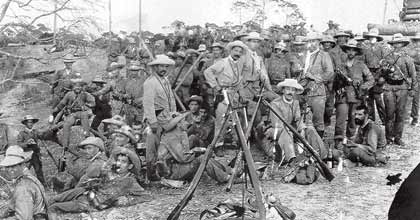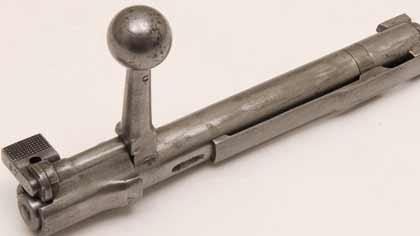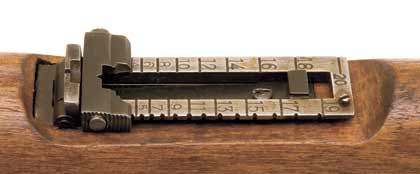September 23, 2010
By Paul Scarlata
By Paul Scarlata
 The Fusil Mauser Espanol Modelo 1893 was one of the most influential military rifles in history. |
On July 1, 1898, during the Spanish-American War, a battle occurred that would be one of the turning points in both U.S. military history and the development of modern, military small arms. During the American assault on the strategic Cuban city of Santiago, 750 Spanish troops defended positions on San Juan and Kettle hills. The attacking force numbered approximately 6,600 American soldiers, most of them regulars, armed with the then-new smokeless-powder Krag-Jorgensen rifle and supported by artillery and Gatling gun fire.
When the brave--if disorganized--assault was over, the Americans discovered to their dismay that they had suffered more than 1,400 casualties. That was almost 20 percent of their attacking force. To have such losses inflicted upon them by such inferior numbers was a shock, and in the usual military manner, an investigation was conducted. The board of officers who conducted the investigation laid the blame where I believe it was deserved, on the superior firepower of the Spaniards' Modelo 1893 Mauser rifles.
Advertisement
The Modelo 1893 was developed by Paul Mauser of Oberndorf am Neckar, Germany. His first military rifle design had been perfected in the late 1860s, and he and his brother Wilhelm had created a company that was to become one of the giants of the international firearms industry. Since the 1870s, their rifles had been adopted by Germany and many other nations, and Mauser's R&D work produced a continual series of improvements that would make the Mauser the preeminent bolt-action rifle in the world by the end of the century.
table#specialTable {padding: none;background: black; font-family: Arial,Helvetica, sans-serif;text-align: left;font-size: 11px;}table#specialTable tr {color: red; background:blue;}#specialTable td {margin: 2px; padding: 2px; background: #cccccc; color:black;border-right: 1px solid black; border-bottom: 1px solid black;}#specialTable td.noright {margin: 2px; padding: 2px; background: #adadad;color: black;border-right: none;border-left: none; border-bottom: 1px solidblack;}#specialTable td.noleft {margin: 2px; padding: 2px; background: #adadad;color: black;border-right: 1px solid black;border-left: none; border-bottom:1px solid black;}#specialTable td.noborder {margin: 2px; padding: 2px; background: #669966;color: black ;border-right: none; border-bottom: 1px solid black;}#specialTable th {margin: 2px; padding: 2px; background: #ffffff; color:black;font-family: Verdana, Arial, Helvetica, sans-serif;text-align:left;font-size: 9px;}#specialTable tr.offcolor td { background: #ffffff;}#specialTable tr.footer {}#specialTable td.footer {}#specialTable h3 { margin: 0; padding:0;font-size: 15px; border-bottom: 2pxsolid #669966;}.bottom { 2px solid black;}
|
Fusil Mauser Espanol Modelo 1893: |
|---|
| Caliber: | 7x57mm Mauser |
| Overall Length: | 48.6 in. |
| Barrel length: | 29.1 in. |
| Weight: | 8.8 lbs |
| Magazine: | Five-round, charger-loaded box |
| Sights: | Inverted V-blde front; V-notch fixed for 300 meters with fold up leaf adjustable from 400 to 2,000 meters rear |
| Bayonet: | Knife style with 12-inch single-edged blade |
Advertisement
Mauser's first successful small-bore smokeless-powder design was the Belgian Fusil d'Infanterie Mle. 1889 chambered for the 7.65x53mm cartridge. Versions of the rifle were also adopted by Turkey, Argentina, Bolivia, Colombia, Ecuador, and Peru. The Model 1889 introduced Mauser's one-piece bolt with front locking lugs. The bolt was drilled out from the rear to accept the firing-pin mechanism. The rifle also had a single-column magazine that was loaded with five-round chargers, better known as "stripper clips."
The idea of using a clip of stamped brass or steel and a flat spring to hold five cartridges ready for loading into the rifle's magazine would revolutionize rifle design and warfare. But just as important was Mauser's detachablesingle-column magazine that could be topped off with loose cartridges at any time, greatly increasing the firepower of the individual soldier. But Mauser realized that the Model 1889 was only a first step and began exhaustive work to produce an improved rifle.
In 1892, Mauser introduced a long, nonrotating extractor that was located along the right side of the bolt. It not only prevented double feeding of cartridges but also provided easier bolt manipulation, as it did not rotate against the cartridge extraction groove.
The next year saw one of the greatest contributions to small arms design: a box magazine that held five cartridges in a staggered row. It was constructed as a one-piece unit with the trigger guard and was flush with the bottom of the stock, making it almost impervious to damage. In addition, it could be charged easier than the single-column type and also fed rounds much more smoothly. This design would supersede almost every other style of magazine used in bolt-action military and sporting rifles. It remains in worldwide use today.
 Spanish soldiers armed with Modelo 1893 Mausers distinguished themselves against U.S. troops during the Spanish-American War and drew attention from military experts of the time. |
Spain adopted the improved rifle as the Fusil Mauser Espanol Modelo 1893, and in excess of 200,000 were ordered from Ludwig Loewe & Co. of Berlin--the corporate owners of Mauser Waffenfabrik. By 1896, the Fabrica Nacional de Armas in Oviedo, Spain had begun manufac-turing Model 1893s and would continue to produce them until 1943.
With the new rifle, Mauser Waffenfabrik introduced the 7x57mm cartridge, and it would become one of the most influential rifle rounds ever developed. It provided sustained velocity, flat trajectory, excellent accuracy, and deep penetration. At the
same time, it produced light recoil. That was a combination of attributes that made it popular with both soldiers and sportsmen alike.
Known in Spanish service as the 7mm Cartucho para Mauser, it consisted of a rimless, bottlenecked case 57mm long topped with a 173-grain roundnose full-metal-jacketed bullet moving at 2,300 fps. It was the high-performance champion of its day when compared to other smokeless-powder cartridges such as the 8mm Lebel, .303 British, and 8mm Mannlicher.
table#specialTable {padding: none;background: black; font-family: Arial,Helvetica, sans-serif;text-align: left;font-size: 11px;}table#specialTable tr {color: red; background:blue;}#specialTable td {margin: 2px; padding: 2px; background: #cccccc; color:black;border-right: 1px solid black; border-bottom: 1px solid black;}#specialTable td.noright {margin: 2px; padding: 2px; background: #adadad;color: black;border-right: none;border-left: none; border-bottom: 1px solidblack;}#specialTable td.noleft {margin: 2px; padding: 2px; background: #adadad;color: black;border-right: 1px solid black;border-left: none; border-bottom:1px solid black;}#specialTable td.noborder {margin: 2px; padding: 2px; background: #669966;color: black ;border-right: none; border-bottom: 1px solid black;}#specialTable th {margin: 2px; padding: 2px; background: #ffffff; color:black;font-family: Verdana, Arial, Helvetica, sans-serif;text-align:left;font-size: 9px;}#specialTable tr.offcolor td { background: #ffffff;}#specialTable tr.footer {}#specialTable td.footer {}#specialTable h3 { margin: 0; padding:0;font-size: 15px; border-bottom: 2pxsolid #669966;}.bottom { 2px solid black;}
|
1893 Spanish Mauser Accuracy |
|---|
| Factory Load | Velocity (fps) | 100-Yard Accuracy (in.) |
| FN 139-gr. FMJ | 2736 | 3.50 |
| Remington 140-gr. Core-Lokt | 2651 | 3.25 |
| Notes: Accuracy is the average of five, five-shot groups fired from a benchrest at 100 yards. Velocity is the average of five rounds measured 15 feet from the gun's muzzle. |
The Spanish Model 1893 was an elegant-looking rifle with a slim, straight-grip stock and handguard made from walnut. Its straight bolt handle stuck out at a 90-degree angle from the rifle, and when the magazine was empty, the rear edge of the follower rose up and prevented the bolt from being closed unless the follower was manually depressed.
The Model 1893's bolt was a simple, cock-on-closing design whose only shortcoming was that it did not provide any way of redirecting gases from a pierced primer or ruptured case away from the shooter's face. Only in later years did some Spanish Mausers include a vent hole in the bolt and receiver to accomplish this.
Two years later, a carbine version was adopted for mounted units and the Guardia Civil, Spain's national gendarmerie. Called the Carabina Mauser Espanol Modelo 1895, it had a 17.6-inch barrel, and it weighed 7.5 pounds.
The first battle use of the Model 1893 was in the guerilla war in Cuba, where it acquitted itself very well, earning a good reputation among the troops of the Spanish army. As the main rifle of Spanish forces during the Spanish-American war--the first time "civilized" troops with smokeless-powder repeating rifles faced each other in battle--its performance was the subject of close examination by most of the world's military authorities.
These studies had widely varying conclusions that were often based upon preconceived notions or existing military tactics. Many of the European powers decided that the results of this war (and those of the soon-to-follow Anglo-Boer War) were aberrations that should not affect established European military doctrine. The resulting massive slaughter of World War I was the price they would pay for their shortsightedness.
But for the U.S. Army, which was on the receiving end of the Mausers, the results were fast and far reaching. Within five years, they replaced their slow-loading Krags with a charger-loaded variation of the Mauser, the famous Model 1903 Springfield.
A substantial order for Model 1893-type rifles came from one of Mauser's best customers, Turkey. The Ottoman empire had been a steady buyer of Mauser rifles since the 1880s, and the Turkish Tüfek 1893 was a close copy of the Spanish rifle; the exceptions were that it was chambered for the 7.65x53 cartridge, and it was fitted with a magazine cutoff--the only smokeless-powder Mauser rifle so equipped. In 1894, Brazil placed orders with Loewe for 7mm rifles and carbines, known as the Modelo 1894, which only differed from the Spanish model in minor details.
 The Model 1893's magazine was loaded with five-round chargers, and it was completely enclosed within the stock. These features were two of Paul Mauser's greatest inventions. |
 The Model 1893's bolt was a revolutionary design. It was a cock-on-closing design with dual front locking lugs and a full-length nonrotating extractor. |
The next year, Mauser modified the basic 1893 rifle, making changes to the boltface, extractor, and follower. Also, a "safety lug" was added behind the bolt handle. Known as the Model 1895 rifle, it became the most popular of the Mausers until the introduction of the Infanteriegewehr 98, four years later.
In 1913, Spain upgraded the 7x57 cartridge with a 139-grain spitzer bullet at a velocity of 2,790 fps (the 7mm Cartucho para Mauser Tipo S). A short rifle, the Mosqueton Mauser Espanol Modelo 1916, was approved for service three years later. It was produced at both the Oviedo arsenal and at Industrias de Guerra de Cataluna.
Model 1893 rifles were the primary battle rifle of both sides during the bloody Spanish Civil War (1936-1939), and production continued until 1943, when a 98-type Mauser, the Fusil Espanol Modelo 1943, was adopted.
Shooting The 1893 Mauser
For this article, I test-fired a Model 1893 rifle from my personal collection that was made at Fabrica Nacional de Armas in 1920 and is in VG+ condition with a worn but clean bore. It has the standard 1913-style rear sight that has a lowest setting of 300 meters.
I fired the Mo
del 1893 for accuracy at 100 yards with FN-made 7x57 ammunition manufactured in 1969 and some modern Remington 7mm Mauser cartridges. Loading the magazines with five-round chargers proved a quick and effortless procedure. With its narrow rear notch and wide front sight, I had to aim carefully, and while its 300-meter setting caused it to print about 7 inches high, once I figured out how much "Kentucky elevation" to use, it performed better than I would have thought. Most of my five-shot groups were in the 3-inch range. Fired with Remington ammo, the best measured 2.5 inches--more than adequate combat accuracy for any iron-sighted rifle of its age.
I enjoy shooting these old rifles and usually find them to perform at a level much higher than most shooters assume they can. While many of today's shooters think of early bolt-action rifles as being cheaply made, the workmanship most of them display is top notch. An engineer in the firearms industry once told me that the handwork required to assemble these early Mausers would make their production prohibitively expensive today.
 The Spanish Mauser's rear sight had a fixed notch set for 300 meters and a fold-up leaf adjustable from 400 to 2,000 meters. |
